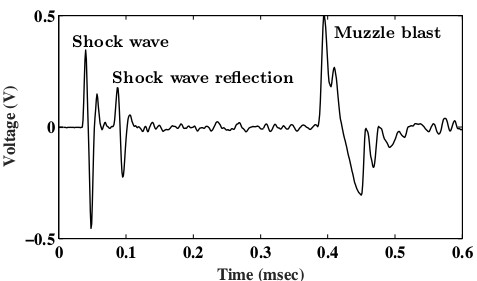Reduced-order modeling of jet noise
Parabolized stability equations (PSE) represent a stability theory that accounts for mild relaxation of the classical parallel flow assumption. It is therefore appropriate for most convectively unstable flows, including high-speed jets. A computationally-efficient prediction of shear flow noise was obtained through reduced-order modeling of the wavepackets associated with the dominant Kelvin-Helmholtz instability using linear PSE. A large-eddy simulation database of two supersonic (Mach 1.5) jets, one isothermal and the other moderately heated, was used to validate the model. The encouraging agreement demonstrated in this effort points to an elegant modeling technique for the complex physics of jet mixing noise.
Selected publications:
- A. Sinha, D. Rodríguez, G. A. Brès and T. Colonius, Wavepackets models in supersonic jet noise, Journal of Fluid Mechanics, 742:71-95, 2014 (download)
- D. Rodríguez, A. Sinha, G. A. Brès and T. Colonius, Inlet conditions for wave packet models in turbulent jets based on eigenmode decomposition of large eddy simulation data, Physics of Fluids, 25:105107, 2013 (download)
Impulse response of jets
Localized arc filament plasma actuators (LAFPAs) hold much promise for flow control applications. The plasma breakdown, occurring over a few nanoseconds, is impulsive with respect to most practical flows. Thus, the impulse response of a high subsonic (Mach 0.9) jet was studied by operating eight LAFPAs arranged around the periphery of a 1 inch diameter jet at a very low repetition rate. Detailed analysis of the phase-averaged near-field pressure acquired on a linear array of microphones reveals the intrinsic response of the high-speed jet. Each pulse of the actuator generates a large scale structure in the shear layer of the jet. Scaling laws derived by operating the jet at four subsonic Mach numbers were used to distinguish this hydrodynamic component of the phase-averaged jet response from the direct actuator noise. An application of linear PSE yielded a successful model of the impulse response. As the forcing frequency increases, the compact waves in the near-field pressure signal overlap each other, indicating interaction of the seeded structures. For this regime, the phase-averaged response is approximately replicated by linear superposition of the impulse response, thereby demonstrating the quasi-linearity of structure interaction.
Selected publications:
- A. Sinha, H. Alkandry, M. Kearney-Fischer, M. Samimy and T. Colonius, The impulse response of a high-speed jet forced with localized arc filament plasma actuators, Physics of Fluids, 24:125104, 2012 (download)
Feedback control of jets
The major aim of control is either to enhance the mixing to reduce heat signature for military aircraft, or to reduce radiated noise for all aviation applications. Both goals require manipulation of the large scale structures in the turbulent jet, although to different ends. Localized arc filament plasma actuators (LAFPAs) were previously demonstrated to have control authority in open loop. The development of jet feedback control was pursued in the following four modules.
A model-free extremum-seeking controller (based on the Nelder-Mead algorithm) was designed and implemented using the LAFPAs as actuators and an azimuthal ring array of near-field pressure transducers as sensors. Quasi-steady feedback was thereby demonstrated successfully for both the mixing enhancement and noise mitigation problems.
An emprical reduced-order model of the unforced jet shear layer was developed based on proper orthogonal decomposition, stochastic estimation and Galerkin projection. The methodology was first validated on a low-Re numerical simulation of a high subsonic jet. Subsequently, velocity and near-field pressure data of a high-Re experimental Mach 0.9 jet were used to create the final 35-dimensional dynamic model. Statistics from the long time horizon simulation of the model were in encouraging agreement with the observations in the data.
The reduced-order model was augmented with a phenomenological model of the effect of LAFPA actuation on the large scale structures of the jet shear layer in the mixing enhancement operating regime. The phase-averaged response of the structures was replicated approximately over a range of actuation parameters spanning the open-loop optimum. A low-dimensional model is thus prepared for development of feedback control laws for high-speed jets.
Another ingredient of a feedback controller is a real-time state estimator. The reduced-order model was reused to obtain this in a Kalman filter framework. This technique was demonstrated to be superior to the static stochastic estimators that are usually proposed for active flow control.
Selected publications:
- A. Sinha, A. Serrani and M. Samimy, Reduced-order modeling of high-speed jets controlled by arc filament plasma actuators, Experiments in Fluids, 54:1428, 2013 (download)
- A. Sinha, A. Serrani and M. Samimy, Development of empirical estimators for feedback control of axisymmetric jets, AIAA Journal, 49(9):1971-1987, 2011 (download)
- A. Sinha, A. Serrani and M. Samimy, Initial development of reduced-order models for feedback control of axisymmetric jets, International Journal of Flow Control, 2(1):39-60, 2010 (download)
- A. Sinha, K. Kim, J.-H. Kim, A. Serrani and M. Samimy, Extremizing feedback control of a high-speed and high Reynolds number jet, AIAA Journal, 48(2):387-399, 2010 (download)
Gunshot localization
Modern gun-battles are rarely waged on open ground where enemies face each other, and the origin of unfriendly and friendly fire are easy to locate. Instead, most combats are now staged in obstacle-dense situations like cities, forests and mountain valleys, where the location of a shooter may be difficult to pinpoint aurally due to reverberations. More importantly, our security forces may not even be present within audible range of all gunshots at all times, due to the highly mobile nature of modern combat. However, in these situations, the personnel would still desire real-time knowledge of the origin of unfriendly fire so as to prepare prompt and effective counter-measures. We are developing a system that can robustly detect and localize gunshots based on acoustics in scenarios of relevance to internal security. A minimal number of low-cost microphones and associated electronic circuitry distributed over the zone of conflict will feed into an efficient real-time algorithm with minimal human interaction.

The acoustic signature of a gunshot consists of two parts. The explosion of the propellant that discharges the bullet is called the 'muzzle blast', and the resultant acoustic waves travel spherically outward from the end of the muzzle. If the bullet travels with supersonic speed, then an additional shock wave is generated that trails as a cone behind the bullet. The two signatures can be distinguished in the microphone signal, and they can be used in concert to pinpoint the location of the shooter. In particular, the algorithms that apply to the muzzle blast are closely related to those used in Global Positioning Systems (GPS). The figure presents the microphone signal recorded in experiment where an AK-47 rifle was fired. The shock wave from the supersonic bullet arrives at the microphone before the muzzle blast reaches it. The ground reflection from these events are also captured.
Robust algorithms that pinpoint the muzzle blast and bullet trajectory are developed and implemented on a standalone microprocessor-based hardware. The bearing angle is estimated up to an accuracy of 3 degrees. On the other hand, prediction of the range of the shooter is known to be problematic, and we too encounter issues with this.
Selected publications:
- A. Sinha and T. Singh, Acoustic localization of gunshots in the presence of obstacles, AIAA Paper 2018-3123 (download)
- S. Bhattacharya, A. Sinha and H. Arya, Closed form solution for acoustic localization of ballistic source, FMFP Paper 2018-168 (download)
- T. Singh, S. Bhattacharya and A. Sinha, Automatic classification of acoustic signals from gunshots, FMFP Paper 2018-189 (download)
